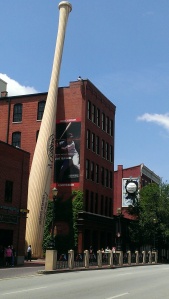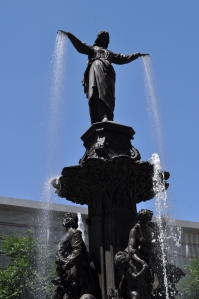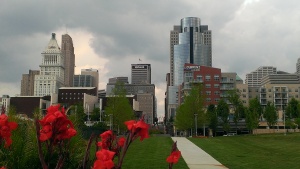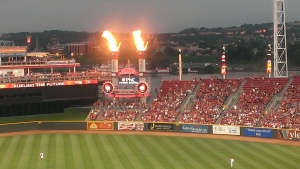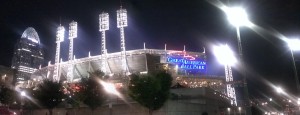“I had no idea the Hall of Fame was waiting for me. I don’t think any youngster ever dreams of that, or thinks that’s possible, because that is a place for fantasies.” ~ Johnny Bench
Game 20. Cincinnati. Reds vs. Pirates
Louisville, Kentucky, home of THE baseball bat, is only an hour and a half from Cincinnati, we learned last night. It surprises me a little that I didn’t think of this earlier, but now that we know, touring the Louisville Slugger Factory and Museum is number one on today’s pre-game list. It’s raining this morning in Cincinnati anyway. So we head southwest to Louisville, and watch the sky.
“What happens if it rains today?” Vicki asks.
“Our schedule will be in trouble. Detroit will be in trouble.”
“Detroit’s already in trouble,” she says.
She’s read ahead in our book, about Detroit being the poster child for urban decay. “Still, it needs to not rain. You worked hard on that schedule.”
Main Street, Louisville, is very charming–lined with buildings from the 1800’s, or looking like they are, and trees, shops, cafes and restaurants. And a Subway with sidewalk seating. Two blocks down the street, we see the 120 foot replica of Babe Ruth’s bat leaning casually against, and towering above, the Hillerich and Bradsby building. It makes us giggle.
Company founder J. F. Hillerich was not interested in baseball bats in the 1880’s. He was interested in stair railings, porch columns, and butter churns. Son Bud was interested in baseball, and the story is that he slipped away one afternoon in 1884 to watch the local professional team, the Louisville Eclipse. When star player Pete Browning broke a bat that day, young Bud offered to make him a new one. So with Pete by his side giving advice on the particulars, a bat was made, which Pete Browning used the next day to get three hits. It would take ten more years, with the company complying with some of the ball players’ ever-increasing requests for bats, refusing a great many of them, before Bud convinced Dad there might be money in baseball bats, and the name “Louisville Slugger” was registered with the U. S. Patent Office, in honor of Pete Browning’s nickname. Today, the company makes around 3000 baseball bats per day, just under two million a year.
Things we learned in the Louisville factory tour: Most bats are made of Ash, though some are Maple. Maple shatters when it breaks, ash splits. Now when you see one break on tv, you can tell your friends what kind of wood it is. They’ll be in awe. The factory has coring devices that create forty inch long, 3-inch diameter ‘billets’, that are then turned on lathes into bats. And while they once hand turned the bats, and a Louisville worker named Juice demonstrated that technique on the tour, they’re all made now on automatic lathes. At about 20 seconds per bat. It is amazing to watch. The average major league baseball player goes through 120 bats each season. The Louisville factory goes through approximately 40,000 trees in one season. And Craig Biggio, Houston’s 3,000 hit future hall of famer, pretty sure, used a maple bat. Our tour guide tells us that, and I can’t help but smile at the mention of my team’s hero. It’s funny how that works.
There is a great deal of baseball memorabilia in the museum, including one of the bats Babe Ruth used in his 1927, 60-home runs without steroids season. This bat has the twenty-one notches the Babe used to keep track that season, just above the Louisville Slugger logo. Until it broke. Yep, you can see that she splintered, not shattered. See how cool knowledge can be? It’s an impressive piece of baseball history to see in person.
Back outside, we admire the 120 foot bat again, and the giant baseball crashing into the window across the street, giggle some more, and admire the brass home plates and bat replicas set in the sidewalk, honoring the great hitters in baseball–Babe Ruth, Ty Cobb, Rogers Hornsby, et al–who all swung Louisville Sluggers.
It rains on us most of the way back to Cincinnati. We’re a little worried. It’s stopped by the time we’re parking in the garage just blocks from Great American Ballpark, but the skies are dark. We walk up Cincinnati’s Main Street, away from the ballpark and the Ohio River, across I-71 and into downtown. In a few blocks, we’re at Fountain Square, in the heart of town. It is the site of numerous free concerts throughout the summer, and ice-skating in the winter. At the center of the square is the Tyler Davidson fountain ‘The Genius of Water’, a 43 foot tall bronze sculpture dedicated to the city of Cincinnati in 1871. (You can probably impress your friends with this, too, if they haven’t already left.) It features a 9-foot tall statue of a woman with outstretched hands, out of which flows streams of water. It is considered the city’s symbol, and an homage to the river city’s continuous debt to the Ohio River. We find it particularly interesting that the fountain is turned off during winter months, and turned back on on the opening day for professional baseball’s oldest team, the Cincinnati Reds. This is all true. I looked it up.
Across the street from Fountain Square, on Macy’s outdoor jumbotron, they’re showing Pete Rose baseball highlights. I’m betting I know how Cincinnati feels about her home town sports hero.
A few blocks from Fountain Square is the locally famous pre-game restaurant, Skyline Chili, which serves their secret recipe over pasta, as well as in bowls. We do both, of course. Our waitress, Raeanne, offers to take our picture with our chili, and our official Skyline plastic bibs.
“So are you guys on vacation?”
“We’re seeing all the major league baseball stadiums,” we tell her.
“All of them? Wow.”
She brings us more tea.
“So you’re just driving to all the cities, seeing baseball games?”
“That’s it.”
“That is so cool.”
She’s been to three Reds’ games this year, she tells us. Was going to go tonight, but she has to work. But that’s ok.
“I think tonight might be sold out. Our machine is empty.”
There are Cincinnati Reds ticket-selling machines scattered throughout downtown, we learn. And we notice there in Skyline an electronic clock, counting down the days, hours, minutes until the next first pitch. Cincinnati loves her Reds.
We tell her it’s a little sad to only have eleven games left.
“Oh, I know!” she says. “You don’t want it to end. I get that!”
Raeanne brings us a goodie bag, for it being our first time in Skyline, and wishes us well on the rest of our trip. She’s put a couple of bibs inside, she tells us.
We still have an hour or so before the stadium gates open, so we walk the six blocks back to The Great American Ballpark for hatpins from the Team Store, and to check out the Reds Hall of Fame and Museum adjacent to the stadium. They were established as the Cincinnati Red Stockings in 1869, just four years after the conclusion of the Civil War, and are professional baseball’s oldest team. As a kid, I remember the baseball season always beginning in Cincinnati for that reason, though that tradition seems to have faded in recent years.
It’s a good baseball museum, with photos of the team in the late 1800’s, as well as wool uniforms, short fingered gloves, and very worn baseballs from that period. There are models of old Crosley Field, the Reds’ home until 1970. Crosley opened in April, 1912, the same week as Fenway, and two years before Wrigley Field. Cincinnati won its first World Championship in 1919, though that World Series victory was tainted by the allegations that the White Sox threw the series. The first night baseball game ever played took place at Crosley Field, in 1935. There are tributes to Joe Morgan, Tony Perez, Johnny Bench, manager Sparky Anderson, and others. There are plaques honoring all those inducted into the Reds Hall of Fame. There’s just the one name missing.
Major League Baseball’s lifetime suspension of Pete Rose for gambling has apparently left Cincinnati unable to honor him in their own Hall of Fame, but they’ve managed to work around that. He is featured heavily inside the museum, and out. There is an extensive exhibit honoring the player nicknamed Charlie Hustle by Mickey Mantle, after watching Pete Rose run full out to first after a walk in a spring exhibition game his first year. There’s a three-story tall collection of 4,256 baseballs, one for every career hit. Outside, beside the stadium, there’s a Pete Rose Way, and a Rose Garden–a bed of red roses, surrounding a single white rose, marking the exact spot where record-breaking hit number 4,192 landed, in the Reds’ former home, Riverfront Park, surpassing Ty Cobb’s career hit total.
And there’s the pitching cage, where you can pitch to a target sixty feet, six inches away, and an automated umpire calls balls and strikes. My first throw careens against the side of the cage.
“Ball!” the umpire calls out.
“I tried to throw that one too hard,” I tell Vicki.
“Try another one.”
This one hits several feet in front of home.
“Ball!”
“Wow. Home plate looks a long ways off.”
“Try another one.”
This one’s closer.
“Ball!”
I’m starting to not like this umpire so much. I grab another ball out of the bucket, and throw something that seems to take forever to get there. I think it was my fastball.
“Strike!” the umpire yells.
“That one displayed the speed!” Vicki says, excited. “It was 54 mph,” she announces, before I can stop her.
“Are you kidding me?”
I’d like to tell you it got better. I threw till I was breathing hard, and there was another strike in there somewhere, but I never reached 60. And I’m pretty sure I need surgery now.
We head outside, and cross the home plate plaza area to the stadium. It’s still sprinkling, a little. Our schedule is in trouble, I’m thinking.
“We wouldn’t have this problem in Houston.”
“I know,” Vicki says.
“We have a roof.”
“I know.”
She’s taking pictures of The Great American Ballpark now, so I’m not going to remind her that Houston’s roof is retractable.
We’re more than a little disenchanted to learn that the stadium’s name, The Great American Ballpark is NOT a poetic homage to baseball’s place in American history, or its status as America’s Pastime, but another sports venue corporate naming casualty, an extremely unpoetic homage to the Great American Insurance Company, whose 2-mile high glass fronted building sits just across the interstate from the stadium. I feel severely mislead.
And in the interest of honest reporting, the outside of the GAB is not particularly attractive. The only brick, and we love brick, is on the museum/team store, and what looks like an almost attached office building. The stadium itself is white painted steel, and glass. Not good-looking, retro steel. Just steel. Cheap-looking steel. No arches, and little in the way of a decorative facade that suggests a noble arena might be inside. Just the white underbelly of the seats.
Inside, though, it’s a beautiful ballpark. The seats are red, like those in Busch Stadium, with all the trim green. Above the centerfield wall is a steamboat, a tribute to Cincinnati’s historical status as a riverboat port. There are smokestacks along the right-center outfield wall. And beyond the stadium, the Ohio River, with its green, home-speckled hills rising up beyond the far bank. There is a connection with our history, with all things Americana, that comes from looking out beyond the stadium walls of a baseball field, at one of our essential rivers. Huck Finn would have liked baseball. It’s the wrong river, and he would have snuck in, but none of that matters.
There’s a tarp covering the infield. There are few people in the stadium, and it’s sprinkling. We have the sense that we may as well just hang around at this very cool place for awhile, and eat stuff. We get a smoked turkey leg and a Prime Rib Sandwich from Mr. Red’s Smokehouse, stand at one of the pub tables under cover, and take it all in. It’s all very relaxing, like we’re practicing watching a baseball game.
The sprinkles stop, and we walk across the open-air outfield concourse to the seats. The tarp is still on the infield, though the grounds crew has done some tarp-rolling maneuvering. Behind the stadium, just across the Ohio, it is raining.
“What are you two up to?” a silver-haired usher asks us. He’s the same usher who asked Vicki what she was taking a picture of a couple of minutes earlier.
“Just watching it rain.”
“It’s a good day for that.”
It starts to rain a little again. A couple walks up out of their outfield seats, and heads over to Red’s.
“Where are you folks going?” he asks, and shrugs. They grin, and find shelter at our old table.
“Think we’ll play?” I ask him.
“Yeah, probably.” He looks at the dark sky. “Maybe. Where are you folks from?”
“Texas and Florida.”
“Yeah, I think I knew that.”
“Yeah, I thought it was a funny question,” I say. And he chuckles.
I tell him we’re going to go exploring, and he takes off his Reds ball cap, finds a Concession Map, and hands it to me. He tells me where all the good eats are, including a Skyline Chili booth.
“Come back and see me,” he says, and we shake hands.
There are quite a few people in the covered concourse, as we all wait out the weather. New stadiums are designed where you can walk the concourse, and have an unbroken view of the baseball field all the while, and The Great American Ballpark is one of the best at this design. We walk along, in no hurry, and look out at the baseball field.
“This is cool.”
“Absolutely.”
The sprinkling stops, and the grounds crew begins to fold, then roll up the infield tarp. We head to our seats, on the 3rd level.
As we walk up the ramp, a father and his son catch up to us. They are wearing red.
“You must not have gotten enough love as a child,” the father tells me, “to go out in public with that Astros garb.”
“Hey, we’re getting better. Sort of.” He’s grinning.
“They even moved you to the other league, to try to help you out.”
“Yeah, that didn’t help. We miss you guys.”
We walk together the rest of the way up. We talk about salary caps, the players’ union, and other stuff I sometimes try to pretend doesn’t exist. His twelve-year old son is wearing a Reds Head Kids Club shirt, and he tells us about that. They get tickets to four games, and some pretty neat on the field interactions with Reds players.
“Course I have to take off work.”
“You get to take off work.”
“I get to take off work.”
He’s very proud of his son, and how much he knows about the game.
“He could manage this team as well as Dusty Baker. I’m pretty sure of that.” His son grins.
“The game needs young fans,” Vicki says.
“Yes, it does,” the father says.
“I get to meet some of the players, out on the field!” his son says.
“I like your shirt,” I tell him. It has a sort of wild haired, sunglasses wearing version of their Mr. Redlegs mascot.
“Thanks.”
We reach the top.
“Well, enjoy the game,” the father says. “And thanks for the talk.”
The tarp is off, the view is great, and the rain has stopped completely. The sun is shining on the buildings across the river. There will be baseball tonight.
Which isn’t good news for the home team, as things go bad for the Reds very quickly. The Pirates’ Starling Marte hits the 2nd pitch of the game to right center for a triple. A single, two walks, and another single later, it’s 3-0 Pittsburgh. Cincinnati’s starter Mat Latos settles down after that, and Reds’ pitchers combine for 17 strikeouts, but the damage was done. The Pirates would get only one more hit after the first inning, but the Reds only managed 4 hits all game off of Pittsburgh starting pitcher Charlie Morton. The smokestacks in right center billow fire with every strikeout thrown by a Reds’ pitcher. They’re supposed to shoot fireworks when the Reds hit a home run, but we don’t get to see that part.
There are three fans decked out in Pirates garb one row in front of us, and a young man in Cincinnati red in front of them, on the first row of our upper deck section, behind home. Late in the game, there’s foul ball hit straight back, in our direction. I stand up, as do the others in front of me. The young man in red leans out over the rail, and makes a great catch. There is applause. The Pirate fan just behind him pats him on the shoulder.
“Great catch!” he says. “I was waiting on it, too! I was ready.” Everyone is laughing, and admiring.
The young Cincinnati fan is all smiles. He passes the ball back to the Pirates fan, who admires it graciously, then passes it back.
“It was a great catch,” he says again.
A Reds fan sitting a few rows farther back, and to our right, jokes that if he had been a real Pirates fan, he would have cold-cocked the young Reds fan, and snatched the ball. Everyone laughs, and all seem to take it in the right spirit. There is more joking, as the Pirates fan defends both his loyalty to Pittsburgh, and his overall sound human nature.
“I guess we learned something tonight about Pittsburgh fans,” the joking Cincinnati fan says. It sounds pompous, it reads as if his remarks are full of arrogance, but they are not. And somehow everyone in our section knows they are not. Swords are lowered. A truce is almost silently announced.
It’s the bottom of the 9th, and the scoreboard tells us it’s Rally Time.
“Why is that guy’s hat inside out?” Vicki asks.
“Hats turned inside out are rally caps.”
“Really,” she says, and she starts counting rally caps around us. “You’ve done that?”
“Sure.”
“Did it ever work?”
“Don’t think so. But it might one day.”
It doesn’t work today, and the Reds go down quietly in the bottom of the 9th. The Reds who hit four home runs yesterday, hit four singles today. The Pirates win, 4-0.
We all stand to leave, and the Pirates fan in front of us delivers a parting shoulder punch, and ‘nice catch’ to the young man with the foul ball. He is holding the ball in one hand. The rest of him is still smiling.

